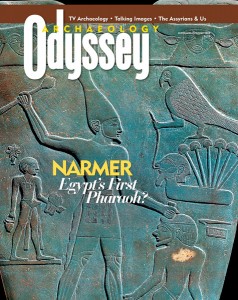Egypt’s First Kings Had Company in the Afterlife

Guided by magnetic surveys that reveal structures buried beneath the desert sands of Abydos, Egypt, 300 miles south of Cairo, American archaeologists have uncovered a First Dynasty (2920–2770 B.C.) mortuary enclosure surrounded by subsidiary graves that show strong evidence of human sacrifice.
Egypt’s earliest historical kings are buried about a mile south of this monumental enclosure, which is one of two large, open ritual spaces enclosed by mudbrick walls being excavated by a team from New York University, the University of Pennsylvania and Yale University. The smaller of the two enclosures (shown) belonged to Aha, the first king of the First Dynasty.
Archaeologists have excavated five of the six subsidiary graves surrounding Aha’s enclosure. Jar-sealings and other artifacts bearing Aha’s name were found in some of the burials; others contained jewelry made of imported lapis lazuli and ivory and the remains of strongly built wooden coffins, suggesting that the graves’ occupants were probably courtiers.
Although the subsidiary graves at Aha’s enclosure were physically separate from each other, they were covered by a continuous mud plaster floor that was created soon after the enclosure was built, indicating that the burials were all made at the same time. The archaeologists believe that various officials, artisans and servants were killed at the time of Aha’s funeral to ensure that the king’s needs would be met in the afterlife.
Already a library member? Log in here.
Institution user? Log in with your IP address.

